A cancer diagnosis often becomes a wake-up call that something in a person’s life is out of balance. This was definitely the case for me and it was the case for Lilly Padilla, Certified Integrative Nutrition Health Coach and author of the book “Anti-Cancer, Habits & Anti-Inflammatory Nutrition”.
Lilly was diagnosed with Ovarian Cancer in 2003. I purchased her book and attended a presentation she gave about nutrition at the Cancer Support Community in 2015 (just a few months after my brain cancer diagnosis and craniotomy). I knew there would be life-changing information in her book so I held on to it all this time. I have been dealing with additional health issues and wasn’t quite ready to receive the knowledge she had to share. Actually, I was resistant because I knew in my heart I needed to make some major changes that I wasn’t prepared to follow through on. I’m ready now (or as ready as I’ll ever be) and as it turns out everything really is connected. For example, the very day I started working on this post, I received a $50 gift card–out of the blue–from a very special person. She was thanking me for help I provided to her non-profit a few years ago and the gift card was for Whole Foods! I saw that as a sign and now here I am…following through with what I believe I’m supposed to understand and share with you.
First of all, Lilly’s journey is fascinating. Her diagnosis led to a career change as she sought to understand what was happening to her body. She focused on wellness and that steered her toward learning about the impact of holistic nutrition. She even traveled to China to study with experts as she was seeking to integrate Western nutritional scientific findings with Chinese Nutritional Therapy (CNT).
Lilly said her main purpose “was, and still is today, to create healthy, happy cells.” Wow! Thinking about health and wellness on a cellular level–well that–that’s just deep! I am excited to introduce you to Lilly and I hope you will enjoy our interview below.
“My main purpose was, and still is today, to create healthy, happy cells.” – Lilly Padilla
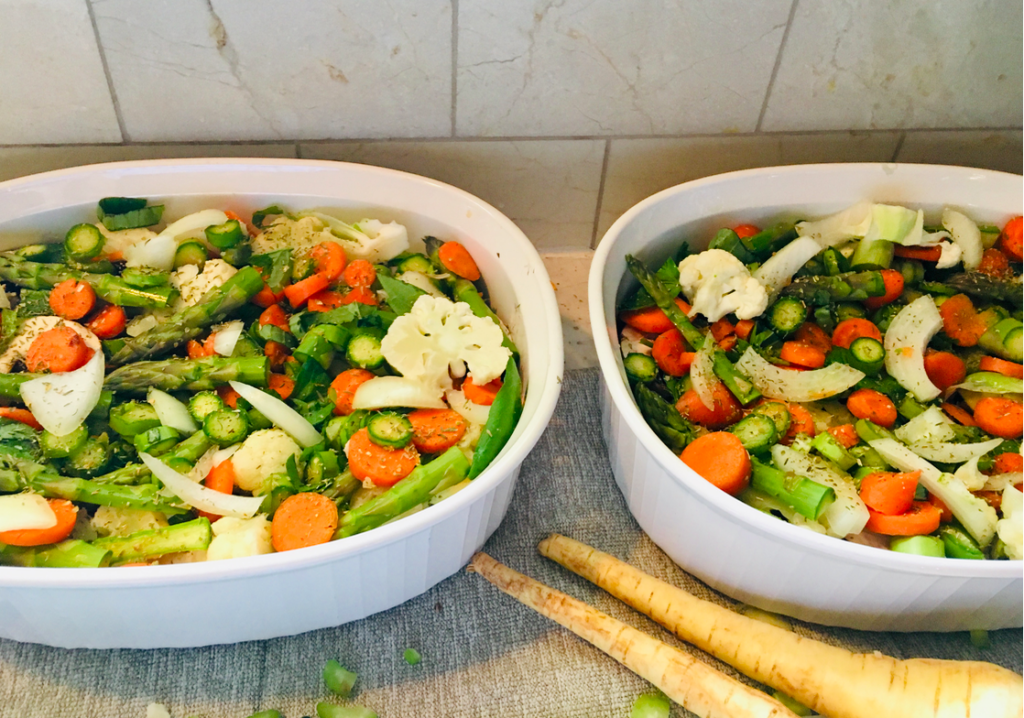
Wendy: Good morning, Lilly. In telling your story, you shared that when your health awareness journey first began (prior to your cancer diagnosis), you hadn’t been feeling well for months, and eventually, you ended up pressuring doctors to give you an ultrasound, a CT scan, and a referral to a specialist. What did that teach you about the importance of self-advocating for your health?
Lilly: Self-advocating is part of self-care. Taking action, listening to our intuition, or gut-feeling about what the body is feeling and its symptoms is our job. We want to learn to listen carefully to the messages which most of the time are symptoms. Listening to your body’s signs and symptoms is being in touch with yourself. I learned to listen, I also learned that NOBODY, KNOWS MY BODY AS I DO, SIMPLY BECAUSE I FEEL IT AND CAN READ IT BETTER THAN OTHERS.
“Listening to your body’s signs and symptoms is being in touch with yourself.”
Wendy: In your book, you went on to talk about your reaction when you first found out you had ovarian cancer. You said, “I didn’t know of the severe damage that one can do to the body with toxic foods, toxic relationships, too much stressful thinking, and negative emotions. It all contributes to the sickness or wellness of cells.” Can you please expand on that thought?
Lilly: Eighteen years ago I didn’t know as much as I do now regarding the damage that stress, especially constant stress, can do at the cellular level. I realized it after my diagnosis. I went back to look at my life at the time and noticed how much stress and negative emotions I was having the year before the diagnosis. Nowadays science is very clear about it. Stress can easily create inflammation and when left to grow it can become chronic inflammation. From there, it can create havoc in the body, including the immune system.
Wendy: After you decided to focus on wellness, you started on your journey to “nutrition and research on both nutritional scientific findings and Chinese Nutritional Therapy (CNT).” How did you know this was the path you needed to take at the time?
Lilly: It was my intuition, friends, and family. They all noticed my passion for holistic nutrition. It was the door that opened up the spark of life for me again. I was constantly comparing scientific findings with Chinese medicine, CNT, and Ayurveda concepts on nutrition and food therapy. It just made more sense to follow both concepts.
Wendy: As you said in your book, the more you learned about holistic nutrition, the more curious you became. This led to going back to school and eventually changing careers. You are now a Certified Integrative Nutrition Health Coach and a Nutritional Chef. How’s that going for you?
Lilly: I’m constantly learning, still as curious as to when I graduated. In nutrition, there are always new findings and new courses to update the old findings. For the last eight years, I have been updating with new classes at Harvard and other universities where they offer courses and fascinating classes about the microbiome, the latest in science. I think that the more we know the better we can help clients and our community of survivors.
Wendy: You write about your goal of starving cancer cells. How did you do that and what does it mean to starve cancer cells?
Lilly: Still up to today, I focus my nutrition on lowering the foods that can contribute to feeding cancer cells, and boost the content of foods that lower inflammation and cancer proliferation. It’s about eating with a purpose in mind. It works for me and according to many of my clients, it works for them too. One has to have a mindset for the GOAL of starving cancer and boosting good bacteria.
Wendy: Can you share the concept of five flavors, and five elements of the earth? How do these relate to our five senses of; smell, taste, sight, touch, and sound?
Lilly: The soil where plants come from provides chemicals, and actions for the food. The food comes into us and creates more than just nutrients. Food also brings an encoded action, thermal nature, that is delivered into our cells. That encoded information makes a chili pepper, for example, hot. The thermal nature of chiles being hot is passed on to our body, the body is able to use that effect to do many actions like helping in digestion or detoxification, but it also can make, for example, blood pressure run higher than is needed for some people.
“Food also brings an encoded action, thermal nature, that is delivered into our cells.”
While a cucumber’s thermal nature is cooling, it might be great for summertime but it can also make some people’s bowel movements run loose–a cold stomach, for example, can be an issue for people with a delicate digestion system. Food is information, the five flavors matter for a healthy balance.
“Food is information, the five flavors matter for a healthy balance.”
Unfortunately in America, we have been trained to eat more of the salty and sweet flavors. However, we need to eat all the flavors as each flavor carries some actions needed to support each system, and each specific flavor works for specific organs. Examples: bitter can be used for certain conditions and organs like daily detoxification, balancing glucose, etc. Sweet can nurture the pancreas, but overusing sweet can be a huge problem for insulin, so moderation and knowing what flavor is needed for which organ is key in supporting balanced health. Most clients at the beginning before they start working with me don’t eat enough pungent, bitter, and sour. How is your daily intake of these flavors?
Wendy: Based on the issues I’ve been having with my esophagus, I’m guessing my daily intake of the five flavors is probably not very balanced. On another note, you have an interesting view of what inflammation tells us about our bodies. Can you share a little bit about that? What are some of the causes of inflammation?
Lilly: Besides eating too many acid-forming foods, not acidic foods, but acid-forming foods like dairy, cheese, alcohol, flours, processed foods; there are other causes of inflammation, one of the most powerful causes is toxicity produced by pathogenic bacteria or bad fungi, and viruses. It is all connected.
I’m working on my new book on nutrition for the microbiome, and how what we eat influences which bacteria we promote to grow in our body. It turns out that the same poor foods that create inflammation, are the same foods that feed the pathogenic bacterias, which produce heavy toxins that will end up oxidizing the digestive tract organs and body filters that we need to preserve for balanced health. Hence, we get sick with inflammation in many organs and digestion and assimilation of nutrients become poor.
Wendy: What role does chronic inflammation play in tumor development?
Lilly: Many studies have linked chronic inflammation with cancer. Actually, cancer is an inflammatory disease that has been consistently in a chronic state, hence it can distort the cells to the point that promotes tumor growth. Learning to watch out for inflammations in the body, when there is a constant irritation, swellings, pain for longer periods of time might be a chronic inflammation around the area. Knowing what it is to be at EASE, will help to avoid DISEASE.
“Knowing what it is to be at EASE, will help to avoid DISEASE.”
Wendy: Can you please provide examples of acid-forming foods vs. examples of alkaline-forming foods?
Lilly: Most vegetables and fruits are alkaline-forming for our blood pH. Especially in a raw form, but even when quickly blanched in the winter cold days, fruits and veggies promote normal blood pH. While most animal foods, especially dairy and cheese are the most acid-forming. Meaning, they promote acidic blood pH, depending on how they are prepared, and how much the person can eat. Also how they are mixed in the same meal, for example; a piece of meat with rice is definitely more acid-forming than, a small piece of chicken served with three or four portions of colorful vegetables in the same meal. We do have the power to alter our chemistry every single time we eat. Serving meals with the purpose of balancing blood pH in mind is a great way to preserve a healthy blood pH, which is key in helping lower inflammation and cancer prevention.
“We do have the power to alter our chemistry every single time we eat.”
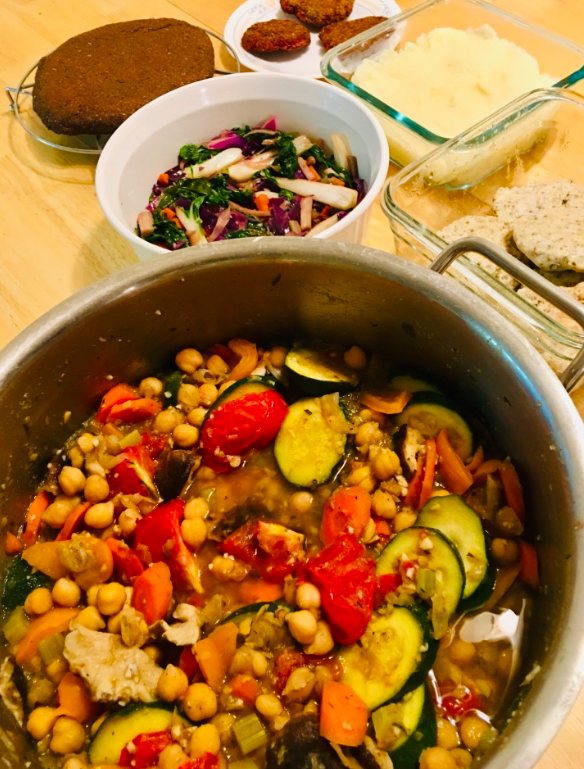
Wendy: Other than food, what are some of the contributing factors that can cause acidic blood?
Lilly: STRESS AND POOR EXERCISE OR ACTIVITY, POOR SLEEP, PATHOGENIC BACTERIA, MEANING GUT DYSBIOSIS (what happens in the Gut doesn’t stay in the Gut it affects every system functioning, including the blood pH. I talk about this in my upcoming book as well. It’s all about Gut health, microbiome nutrition, and delicious nutritious RECIPES for healthy bacteria)!
Wendy: I will definitely need to get that book when it comes out. In the meantime, what do you mean when you say, “We are a process in motion?”
Lilly: Everything in us is constantly moving, changing, and in motion. Just like any other living creature, our body is part of the ecosystem of the earth (a process), which is in progress, and changing. So our internal ecosystem, our microorganisms are always changing, even with the seasons. What we eat, how much exercise we get, how we rest and sleep, etc., it’s all part of the ecosystem process and circadian rhythms. We remake ourselves and renew every tissue, every part of the body gets renewed including the Gut lining and our muscles. Our organs get renewed according to our lifestyle and eating habits. Some renew much healthier than others.
Wendy: After my brain biopsy, I had an insatiable craving for sauerkraut. Truly, as my friends and family may recall… I literally put sauerkraut on top of everything I ate. What does that tell you about my body chemistry at the time?
Lilly: Your internal ecosystem, your microbiome was probably depleted. After the brain biopsy, your GUT was asking for good bacteria (sauerkraut is full of healthy bacteria) to repopulate the Gut and RE-CONNECT THE BRAIN-GUT AXIS the main connection between the Gut and the brain microbiome. There is plenty of research on that subject right now. It’s a fascinating topic in health.
Wendy: What are a few of the things we need to do to create healthy, happy immune cells?
Lilly: This is a great question, hard to answer in a short paragraph. For the most part, new research in science, as well as ancient medicines, talk about the link between digestion and the immune system. The Gut bacteria are also part of the digestive system, but they all share a huge link and work along with the central nervous system and our Vagus nerve. It is an entangled result of having a calm happy Vagus nerve, that sends signals to our microbiome.
Wendy: What is the difference between “beneficial stress” and “harmful stress”? How can awareness help?
Lilly: BENEFICIAL STRESS is short, perhaps from exciting projects, goals, etc. HARMFUL STRESS can be constant, it can be fear-driven, perturbing sleep, eating routines, and rest. PERSISTENT STRESS IS DETRIMENTAL TO OUR IMMUNE SYSTEM AND ENJOYMENT.
Wendy: What does the saying “digestion starts in the mouth” mean?
Lilly: Enzymes and bacteria are found in our mouth. The saliva in our mouth has a big purpose in helping with digestion. When we mix each bite of food with saliva it starts the right process of digestion. By chewing properly, we ensure the breakdown of foods into nutrients. Saliva is very important for that process and so is chewing well–until the food is almost liquid. Remember the stomach doesn’t have teeth.
Wendy: What role do temperature and food combinations play in a healthy diet?
Lilly: TEMPERATURE MATTERS TO OUR ENERGY. Each time we eat warm or cooked foods we save energy. When we eat cold or raw food we spend more energy as the digestive system has to heat up the food, even more, to break down the components. Also, it takes longer to assimilate a cold meal than a hot cooked meal. As people get older that’s one reason they prefer soups and cooked meals (it saves energy but it is also more nourishing and gentle for the digestive tract). The same can be said for food combining. Simple meals digest better. Good food combining makes it easier to assimilate nutrients, as it requires fewer enzymes to be produced in order to break down and digest the whole meal.
I also see it in my clients with stomach or pancreatic cancers. They start eating less and prefer one or two foods at a time. Complicated meals where there are protein and carbs together can require more enzymes and energy to be digested. While a simple mix of protein and vegetables, especially leafy greens, supports the digestive system and assimilation is easier.
Wendy: In the last chapter of your book you share holistic recipes. You write about creating the recipes “with food synergy in mind.” You say that your goal, “is to send the right message consistently to each cell.” Would you like to share one of your recipes here?
Lilly: Sure! (See below):
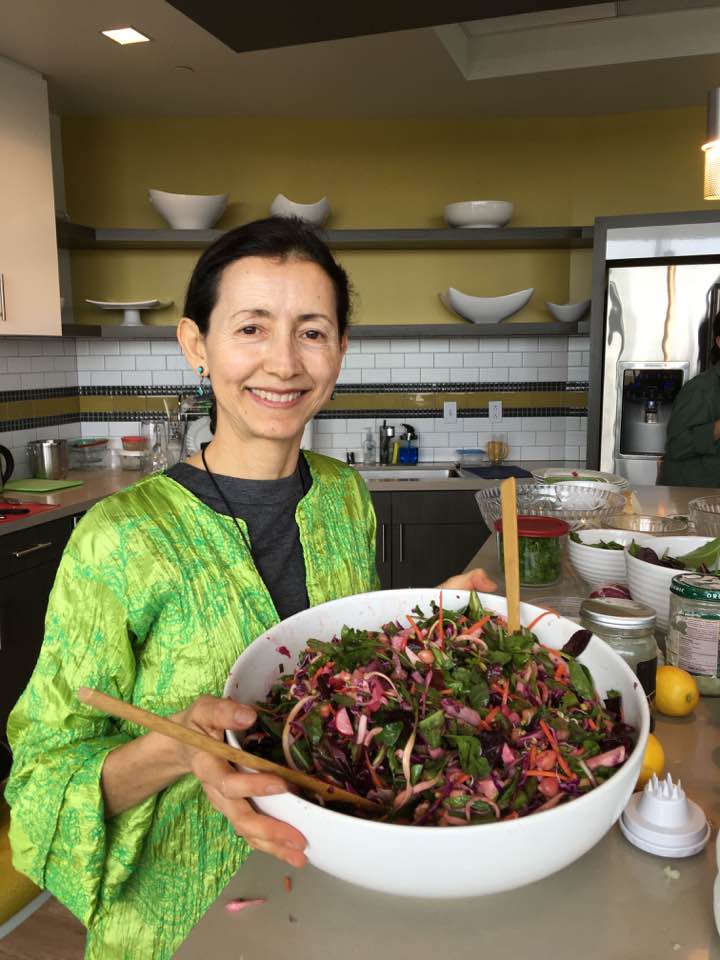
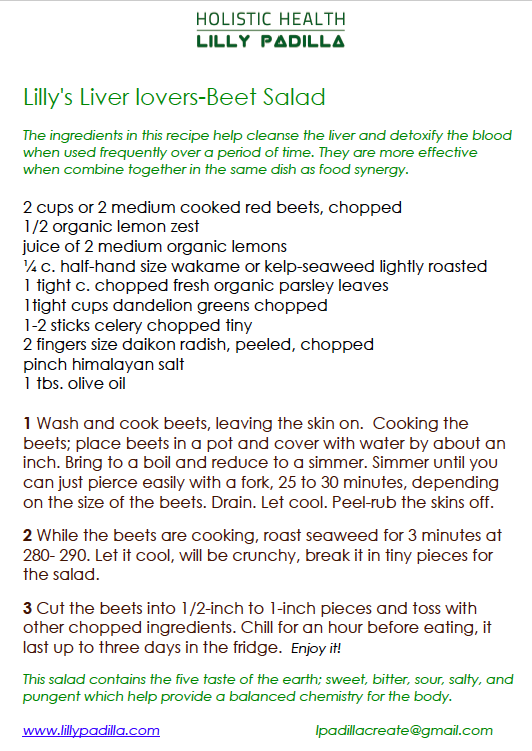


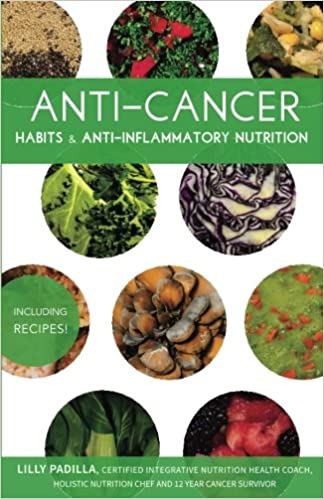
 Hello. My name is Wendy and I’m a recovering workaholic. I'm also a brain tumor/cancer survivor.
The purpose of this blog is to share my experiences, memories, resources, and self-discoveries as I continue to transform from a workaholic into a more balanced person. I have read several books and stories about others who have had similar experiences
Hello. My name is Wendy and I’m a recovering workaholic. I'm also a brain tumor/cancer survivor.
The purpose of this blog is to share my experiences, memories, resources, and self-discoveries as I continue to transform from a workaholic into a more balanced person. I have read several books and stories about others who have had similar experiences 